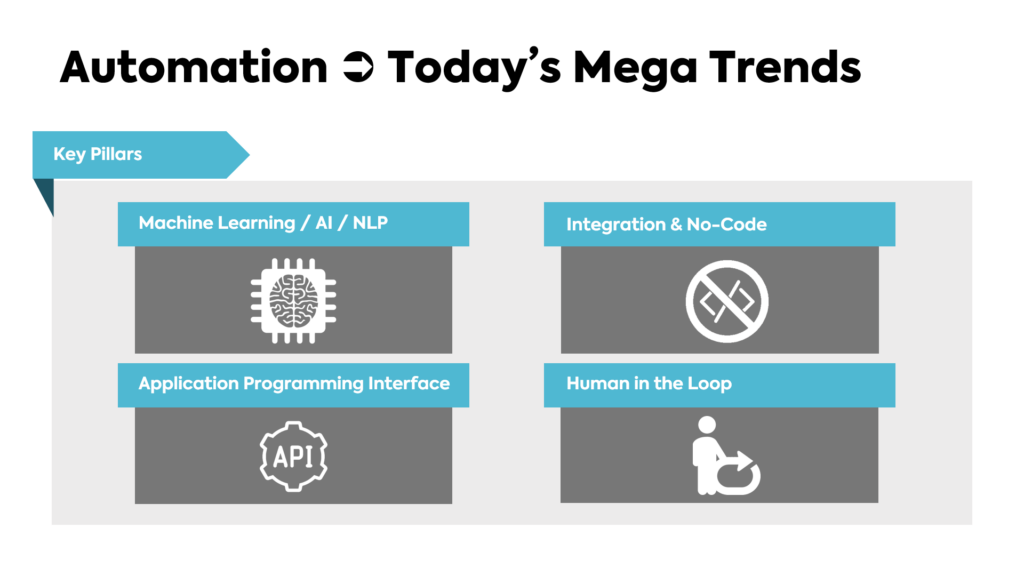

For years we’ve been hearing that robots are going to take over the IT organization. And clearly that hasn’t happened quite yet. But automation is taking root everywhere across the enterprise. Whether they’re plugging into the latest APIs or still running mission critical apps on COBOL, organizations across every industry are automating repetitive processes to gain efficiency and cut costs.
What’s working? Where does automation fall down? Where is the market headed? As always, our distinguished panel of speakers offer compelling insights on the topic.
Our speakers:

Key Takeaways
The Four Key Pillars of Automation
Every major technology innovation has involved some type of automation. But in recent years the pace of automation has accelerated, creating huge opportunities moving forward.

Automation today breaks down into four fundamental enabling technologies. The first is the ability for machine learning and AI to impact actions within an application. Think about Wayz for navigation, or how Gmail’s automated reply suggestions means you rarely have to type anymore. AI and ML are the underlying superpowers for enterprise apps.
In addition, application programming interfaces have become powerful building blocks for new applications. For example, collecting money from customers used to require building your own payments infrastructure and manually connecting to hundreds of different payment processors; now you can just plug into Stripe’s API. Simply by pulling together a series of APIs, enterprises can quickly build sophisticated applications.
Integration and No-Code use APIs to seamlessly connect hundreds of applications within an enterprise, without the need for lengthy development cycles. And instead of replacing us all with robots, next-generation automation companies are bringing humans and machines together to inject higher order thinking into each process.

This ecosystem breaks down into a handful of distinct categories, from straightforward functions like task automation, to more complex endeavors such as process automation using API platforms and data automation built around SaaS tools. All of these are extremely hot areas for investment. Our belief is that large sustaining companies will emerge in each of these different areas, while some API and SaaS platforms, such as Twilio and Marketo, may start to converge.
What Enterprise Automation Looks Like
Though automation is happening across all facets of enterprise IT, three areas in particular – data centers, security, and workflow – are worthy of special attention.

The Autonomous Data Center
Infrastructure, IT Ops, and DevOps are converging toward the concept of the autonomous data center. As with driver-less cars, automated infrastructure has the ultimate goal of reaching the level where humans within an organizations can express an intention – “We want this core line of business applications to always be up” – and leave it to enterprise automation to figure out exactly what that means.
According to IDC, 92% of enterprises have the explicit goal of enabling a fully autonomous data center over the next two years.

Security Automation
A second key area of enterprise automation revolves around security. Here you can make a powerful financial argument for implementing an incident response team and automating processes around that. According to an April 2020 study by IBM, having an IR team and tools in place can reduce the average cost of a data breach by $2 million. If you’ve automated your security response, you can expect to save more than $3.5 million.

One of the more surprising security use cases is DevOps (which is one of the fastest growing within security automation). Recent compromises of the development life cycle at companies like FireEye and Solar Winds are examples of why enterprises are showing a lot more interest in application security and DevSecOps.
While there are differences in emphasis between verticals – healthcare orgs, for example, are focused on protecting HIPAA data, financial services firms are concerned about PII – in general, enterprises are looking to automate these six bread-and-butter use cases.
Workflow Automation
Two-thirds of companies today are using or planning to use robotic process automation to handle repetitive tasks within HR, finance, customer service, and order processing. But RPA can only take you so far. It’s like trying to rebuild your car’s transmission using nothing but a Philips head screwdriver. Ironically, there’s still a lot of manual labor involved in getting RPA to work inside an organization, which makes scaling it to multiple workflows more challenging.

As a result, we’re seeing enterprises layer other tools on top of RPA, such as task and process mining, which measure what employees actually do every day. And they’re using AI-based hyper-automation platforms that identify where the organization will see the greatest return from task automation, isolate best practices in each process, and orchestrate them to fulfill different business functions.
The automation of automation is one of the most exciting spaces to watch.
A Real World Perspective
Despite all the many shifts in technology over the years, the only real game changer has been automation. IT budgets aren’t increasing, and driving costs down in one area just moves them to another area. So technology practitioners have always needed to figure out how to do more with less.
Organizations looking to automate should not underestimate the impact it will have on company culture. It forces people to think, ‘What is this going to do to my job’? It requires a lot of education around what people are going to gain versus what they will be asked to give up.
Ultimately, IT boils down to three things: Meeting your obligations to keep the lights on, mitigating threats as they arise, and looking for opportunities to help the business grow. Automation helps reduce the amount of time you spend on the first two items so you can spend more time focused on the last one. And the best way to drive automation through the organization is to have sufficient development capabilities in house.
To quote Steve Ballmer…

